We’ve seen it happen – drought, flood, pandemic – the stock on the shelves empties out fast, and prices begin to skyrocket as people start stockpiling too late.
But those who have prepared for droughts can sit pretty, knowing they have enough to last them at least a year or two until the drought breaks.
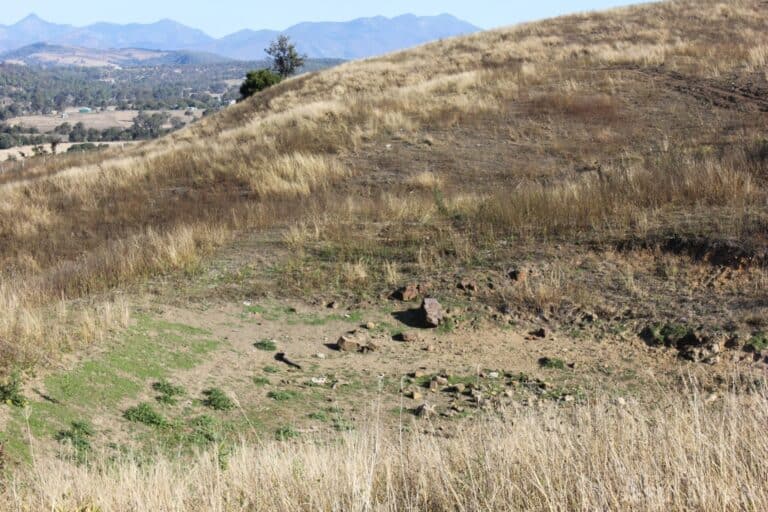
In what follows, I’ll reveal the 24 most important things to get in preparation for a long or a short-term drought.
1. Buckets
Buy extra buckets so you can re-use water where possible, and cart it across to where it is needed. A lack of water may mean insufficient pressure in hosepipes, and in drought conditions there is usually a ban on using hosepipes.
Tip from someone who has lived on two continents ravaged by droughts, Africa and Australia: learn to use water at least 4 times over.
They say showering saves water – yes you use less, but unless you catch some in a bucket most goes down the drain – if you are really well-organised it runs off into the garden.
Bathing uses more water but you can use it a number of times – bath yourself, and then the kids in the same bathwater. Next, wash your clothes in the bath.
After that take out a bucket to mop the floors, and a bucket or two to flush toilets, and lastly, take the remaining buckets of water to your garden. Just ensure the soap and laundry products are eco-friendly.
When drought strikes it is harsh as reserves of water run low, even though you may have thought you had a lot saved. Until you don’t have replenishments, it’s hard to comprehend how much water stock and humans need per day.
People need a gallon of water a day for drinking – children, nursing mothers and people with chronic illnesses need more, so plan accordingly, and you’ll need extra in case of medical emergencies – wound washing or rehydrating.
Make sure everyone is adequately hydrated as the heat accompanying a drought can cause sunstroke.
2. Rainwater Tanks
You can never have enough water stored for droughts – every single construction on your property, no matter how small, should have gutters attached leading into a rainwater tank, and make sure you set this up in the good times when you have enough cash to buy a rainwater tank every few months to add to your store.
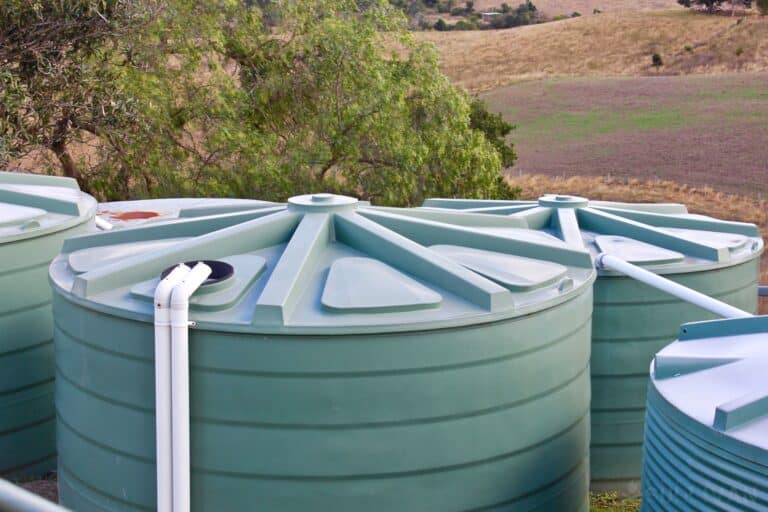
In the photo above there are five 5000 liter tanks (=1320 gallons) – that’s 25,000 or 6,600 gallons litres stored for a household of two people. This is the only source of water for the household as there is no town water.
Then for garden and as extras every small shed on the farm has at least one tank constructed next to it to store water.
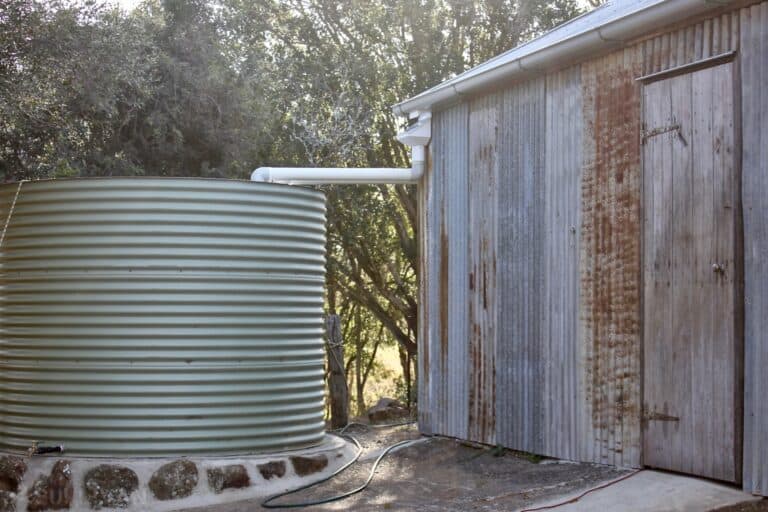
3. Grey Water Systems and Spare Parts
See how to build one here so you can use water from the kitchen sink, bathwater etc for growing vegetables safely:
4. Rainwater
Rainwater tanks and reservoirs (fed from a borehole) are best as ponds tend to dry up in droughts due to evaporation – however if you have a large enough water tight pond that certainly helps – it all depends on the size of the property and the number of animals you have.
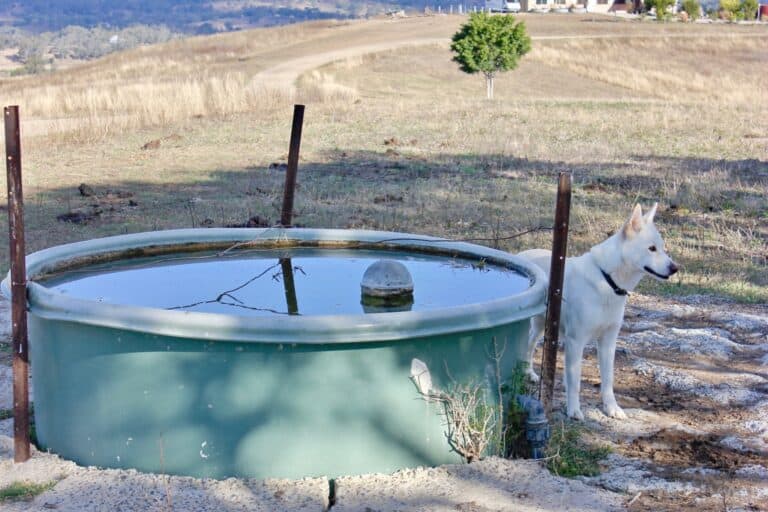
Watch this video to see how a polymer can help slow water seepage – this explains it very clearly. The video is Australian, but the product is available in the US:
If you have a major leak in the pond wall or the soil is unsuitable for holding water then the product may not work. Bentonite clay can be added to the pond to create a seal, but this is not always effective.
The best thing is to get an expert out to assess your pond construction, soil and positioning, and give professional advice. The soil may need compacting while the pond is empty.
If you have no animals near the pond, and it’s small enough, you can use a plastic liner weighted with rocks to keep it in place.
The pond in this picture, half way down a hill, is good for wet seasons, then the cattle don’t have to go to the pond in the valley for water, but in droughts when the water table drops, seepage and evaporation take their toll.
The ground may not have been suitable, or not compacted, or the wall not sufficient to prevent leaks. The farmer in this case did try Bentonite clay, but it did not work.
However, constructing ponds to catch runoff water, even though some may be lost to seepage or evaporation will certainly help.
5. 55 Gallon Drums
For people in suburban areas rain-barrels are the way to go if you don’t have room for a large rain tank. Here you can use the stored rainwater for laundry and general household use.
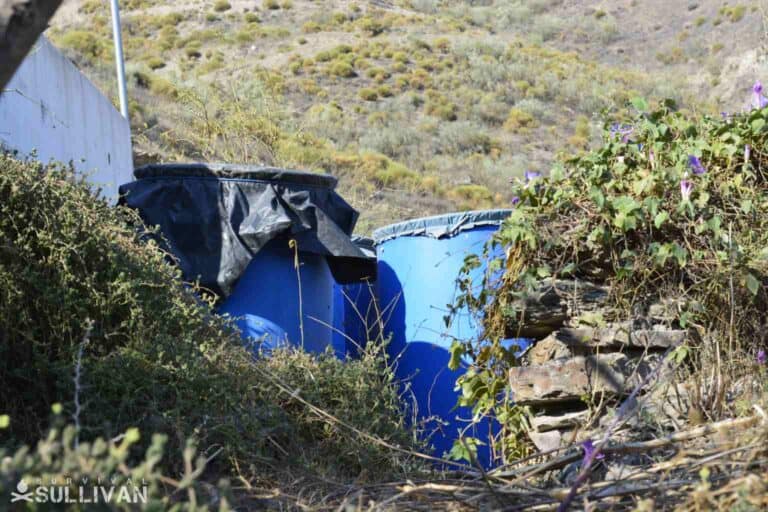
See how to catch rainwater in plastic barrels here.
6. Bottled Water
Store more than you think you will ever need – I know its heavier, but preferably store in glass bottles rather than single use plastic bottles. Make sure the expiry dates are clearly visible and use the oldest first, replenishing stocks when you can.
When water shortages hit and you have to buy water, it becomes incredibly expensive, so buy in advance while it is still plentiful. Either purchase bottled water or prepare water by boiling, filtering, or adding bleach.
Here’s how to make a filter using natural materials and a 2 liter bottle:
7. Food
- Don’t overdo the dry goods. Many people buy dry goods to save for drought times. But remember, rice and pasta take up quite a bit of water to produce a meal, as do corn meal, dry beans, and flour.
- Choose canned goods that already have moisture content like peas, corn, beetroot, and carrots.
- Frozen veg – when fresh vegetables are in short supply you can haul out the frozen peas, corn, carrots, peppers, broccoli and other frozen vegetables.
- Tinned protein – choose tuna, salmon, chicken and turkey. Tinned ham is also good choice. Some canned beef products don’t taste too good – someone said it all tasted a bit like dog food – but that’s a personal statement – go with what your family enjoys.
- Freeze meat – if you have access to a large freezer and reliable power it may be better to buy meat and chicken when prices are good and freeze in advance, making sure it is well wrapped and sealed, to use in the lean times. During drought many farmers are forced to send the animals they can’t feed to market and one school of thought predicts price drops, however, corn is used to fatten cattle for the meat trade and the high price of corn may make the meat even more expensive, so it is probably safer to stock up.
- Dry fruit and vegetables – stock up on dried fruit, or make your own, because fresh fruit will be in short supply or very expensive if imported.
- Make pemmican and beef jerky -meat may be in short supply after a drought as animals will have lost condition and farmers will be keen to build up their stocks so possibly won’t be supplying a lot of meat after losses due to dehydration, so make sure you have made some pemmican – see how to do it here, and make jerky.
8. Fire Extinguishers
Drought conditions increase the risk of fire as the grass will be tinder dry. Make sure fire extinguishers have been checked, and are in place where ever they may be necessary.
Powder fire extinguishers will save water. Barns, hay sheds and feed rooms need to have fire extinguishers. You can go old school with the metal buckets holding sand and water ready to use – but it’s essential they are filled and ready to use at a second’s notice.
9. Disposable Cutlery
You don’t want to waste water washing dishes so buy eco-friendly compostable paper plates, bamboo (also compostable) cutlery rather than plastic, paper serviette and towels – they can all be added to your compost, or mulch afterwards.
10. Hay
Make hay while the sun shines! Build a shed to keep hay dry, and stockpile lots of it to feed your animals.
The cost of feed skyrockets when drought shows up, and everyone is trying to buy up what is left as they desperately try to keep their animals alive.
11. Sawdust
If you have access to sawdust from local lumber mills or from your own use on the homestead, it can help keep cattle going, although the cellulose lignin bond does makes it harder for them to digest.
If you can, add nitric acid to weaken that bond, and boil up into a mash, however recent laws in relation to nitric acid may make it impossible to obtain. The cattle will eat plain sawdust if you cannot process it as above.
This is not a common source of roughage for cattle so it should not be difficult to obtain prior to the drought, and even during drought conditions.
12. Livestock Feed
Pelleted horse feed only has a maximum shelf life of around 6 months, so make sure you buy when you can get it prior to the drought setting in. It should be supplemented with hay.
While horses are non-ruminant, a change to their diet should be introduced gradually, as it is with all ruminant animals, otherwise they may get colic, or laminitis (founder) a painful condition where tissue become inflamed in the hoof region.
Avoid sweet feed in a drought – it has lots of molasses which the horses love, but sweet stuff makes animals thirstier.
Store rice hulls, maize stalks, straw and hay and sugar cane for pigs, goats and cattle, which will help to fill them up, and provide roughage if you are also feeding grains and vegetables or fruit that is available from your homestead.
Store cereal grains like wheat, barley, maize, sorghum and commercial pellets for your goats. Goats, like cattle, and sheep, have to be introduced to drought rations gradually. This is because these rations are high in starch and low in fiber.
Their stomachs need some time to become accustomed to the change in diet as their rumen will need to adapt to accommodate the changes – if this is not done gradually a sudden dietary change can cause grain poisoning.
The rumen bacteria produce an excess of lactic acid resulting in the animal’s gut processes slowing, and they can become dehydrated and die.
Don’t forget your chickens! In a drought, they won’t get as much fresh stuff and will need supplementary feeding, so whether it is corn, laying mash or other feed, make sure you have plenty of it, that it’s in bins where insects and rodents can’t get at it, and you have a desiccant to prevent mold.
13. Seeds for Caged Birds
If you have caged birds store seed for up to six months or more making sure it is in rodent proof bags with a suitable desiccant to make sure it doesn’t get moldy.
14. A Dog That Is an Efficient Rat-Catcher
Get in early and prepare for the lean years, don’t wait for the spectre of drought before making changes. Make sure barns and outbuildings are pest free – rats will eat a large portion of your stockpile of food for animals, and can wreak havoc in your home as well.
Jack Russell terriers are the best rat-catchers out (better than cats) and you are not relying on having to keep buying dangerous poisons to keep rodents under control, so get to an animal shelter and pick up your best friend for life.
15. Compost
In a drought the soil dries out and becomes loose and dusty. Get in early by making and stockpiling lots of compost to work into the soil to retain moisture.
16. Mulch
Keep cardboard, leaves and other mulching materials like newspaper so that soil is covered with a layer of mulch to preserve moisture.
17. Previous Year’s Harvest
Can and freeze or preserve as much as possible so that you have food in reserve, and preserve potatoes so you have seed potatoes for the new season when the rains finally come.
18. Plant Edible Native Shrubs, Trees and Ground Covers That Are Water-Wise
For example Tepary beans native to the South West can survive in drought conditions, and black-eyed peas don’t need much water.
19. Heirloom Seeds
Collect heirloom seeds from crops to ensure you have non-GMO seed to plant when the drought breaks – seed will be in short supply from poor harvests in the previous years, and seed brought in from other areas or overseas will be expensive.
20. Hydroponics and Aquaponics Systems
Get a system that re-uses water like an indoor hydroponic garden, so you have fresh greens during the drought.
21. Water Filters
Disclosure: This post has links to 3rd party websites, so I may get a commission if you buy through those links. Survival Sullivan is a participant in the Amazon Services LLC Associates Program. As an Amazon Associate, I earn from qualifying purchases. See my full disclosure for more.
You’ll need these so you can purify water when bottled supplies run low and you are forced to use alternative sources of water. The Big Berkey will ensure the water from your tanks is safe or general use.
And if you run out of bottled water and are relying on rainwater tank water then the countertop water filter jug to filter out heavy metals.
22. Water-Saving Faucets
You can retrofit your bathroom and kitchen with these to cut water consumption.
For example, a Watersense faucet will deliver the same performance at 1.5 gallon per minute – 30% less than the usual 2.2 gallon per minute, which is standard. You can learn more about them here.
23. A Dehumidifier
While a dehumidifier will keep the home cooler plus you can drink the water which is pure because on evaporation the impurities are left behind – it may taste a bit different to tap water, the best thing to invest in is a water from air unit like this with filtration system to ensure the water is pure:
You can get one here.
Conclusion
Drought can cause anxiety and depression as people see their lives dwindling, struggle to keep their livestock alive, and are often placed under severe economic pressure. Small streams, dams and lakes may dry up, and it will take a couple of good seasons of rain to restore them.
Make sure that you have stocked up on as many water-saving or water-generating devices as possible and use every drop of rainwater you have managed to store, wisely.
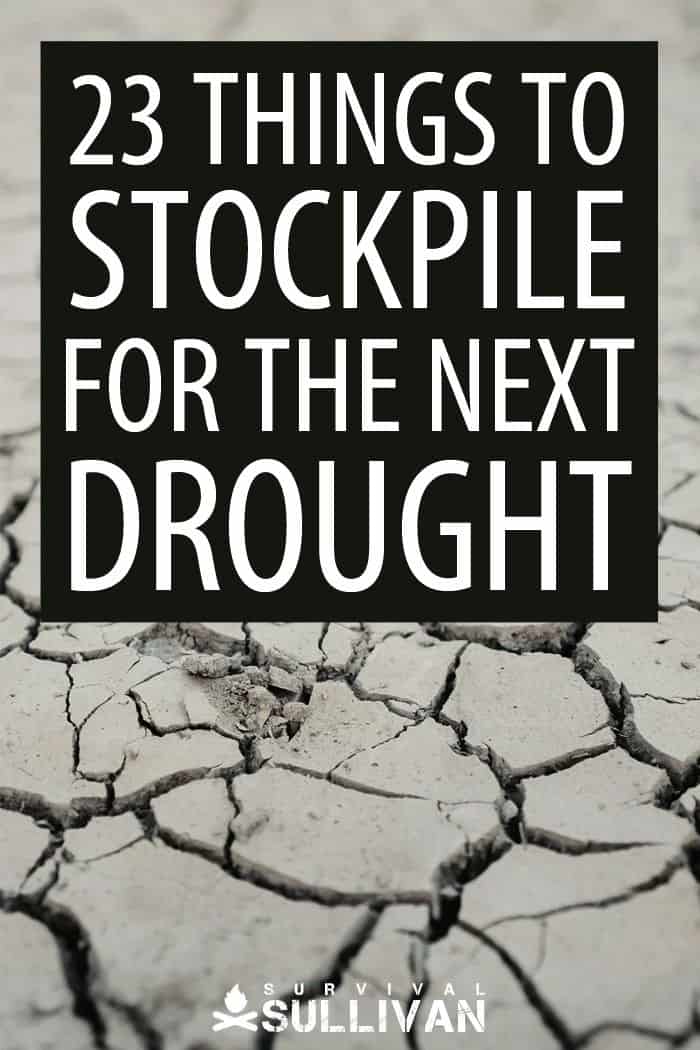

Traveler, photographer, writer. I’m eternally curious, in love with the natural world. How people can survive in harmony with nature has fueled my food safety and survival gardening practices.
At the age of 12, I found a newspaper advertisement for a 155-acre farm at a really good price and showed my parents one Sunday morning. They bought it and I happily started planting vegetables, peanuts, maize and keeping bees with the help of the local labor.
Once I married wherever we moved it was all about planting food, keeping chickens and ducks, permaculture and creating micro-climates. I learned how to build wooden cabins and outdoor furniture from pallets, and baked and cooked home-grown produce, developing recipes as I went along.

Dehumidifers produce distilled water. A bit of caution about drinking distiller water for a long period of time. But distilled water can be used for other purposes that doesn’t involve ingestion. IF thinkgs are that bad, running a dehumidifer to cool the room and produce water might be the least of your worries.
How about a coal stove? Coal stores forever and termites won’t infest your barn/house.
9. Disposable Cutlery
Learn to eat without cutlery. Look at countries like India here a staple food is the ROTI, a flatbread they tear pieces off and use like a spoon